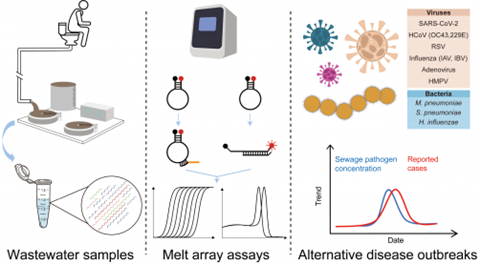Researchers from Nanchang Center for Disease Control and Prevention, et al. have conducted a study entitled “Two-step wastewater surveillance reveals co-circulation of respiratory pathogens during the 2023–2024 influenza season in a low-resource setting”. This study was published in Frontiers of Environmental Science & Engineering, Volume 19, Issue 5.

Clinical surveillance for respiratory pathogens has traditionally been challenging in low-resource settings, such as Western China. A low-cost wastewater monitoring network offers an alternative solution.
READ MORE: Sustainable wastewater surveillance methodologies in the post-COVID-19 era
To explore this, the researchers first compared the sensitivity of a MeltArray-based qPCR assay, which detects 25 respiratory pathogens, with singleplex qPCR using both mock and real wastewater samples. They then employed this MeltArray assay to detect these respiratory pathogens in wastewater from a low-income region in Xi’an city from September 2023 to January 2024.
Following this, qPCR and MLST were employed to quantify the dynamics of positive respiratory pathogens and confirm their genotypes.
Unusual surges
Results showed unusual surges in sewage influenza A virus (IAV) and adenovirus levels starting in October 2023, persisting until late December. Additionally, influenza B virus (IBV) outbreaks were identified beginning in late December. These findings matched the positivity rates reported by a sentinel hospital.
For coronaviruses, HCoV-229E/OC43 were consistently detected in wastewater, while SARS-CoV-2 was occasionally found. The qPCR assays revealed continuous increases in sewage Mycoplasma pneumoniae and Hemophilus influenzae concentrations since September, both peaking in October. Genotyping confirmed the circulation of specific bacterial genotypes in the region.

”Therefore, to the best of our knowledge, this study is possibly the first to evaluate the efficacy of qPCR assays for wastewater monitoring of respiratory bacterial pathogens. Thus, these findings provide significant insights into the co-circulation of various respiratory pathogens during the autumn and winter of 2023, thereby suggesting that wastewater surveillance could be a powerful tool for the early warning of respiratory diseases,” the authors said.
For more detailed information, the full paper is available at: https://journal.hep.com.cn/fese/EN/10.1007/s11783-025-1981-z.

No comments yet